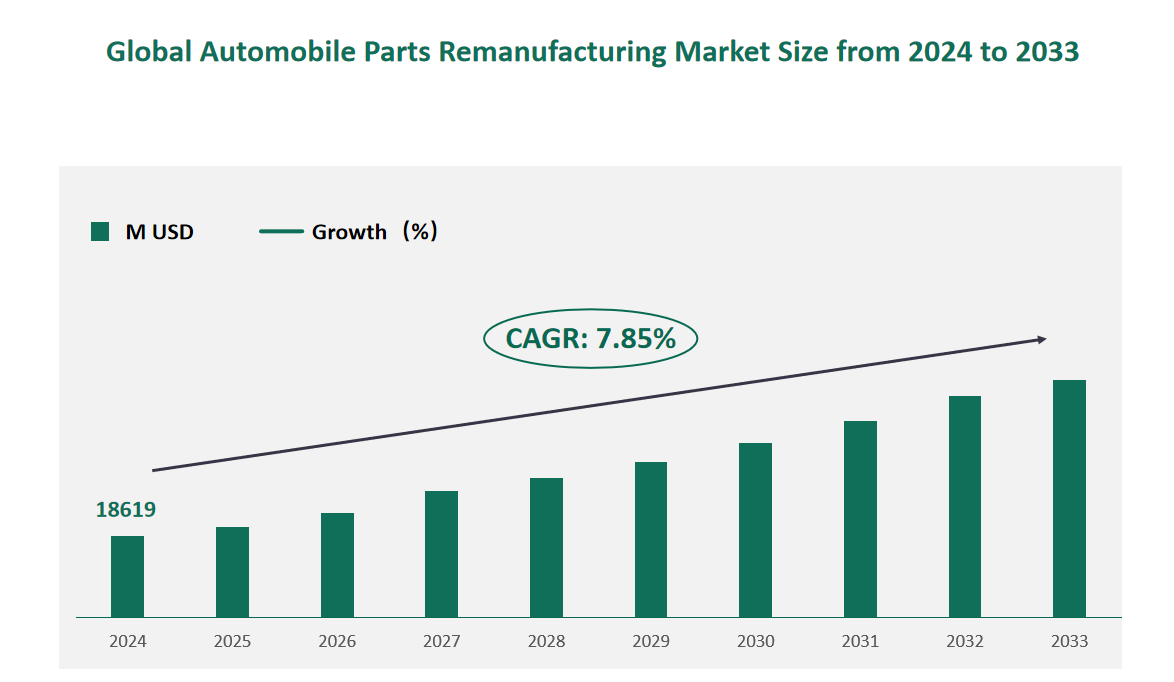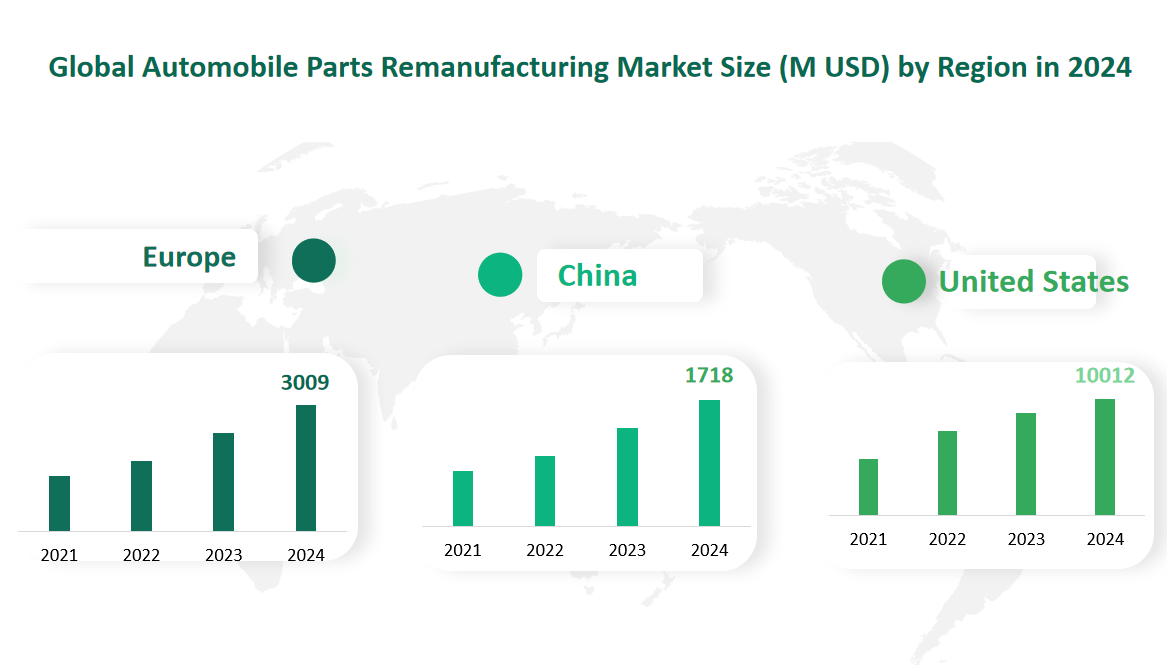1 Global Automobile Parts Remanufacturing Market Size (Value) and CAGR (2024-2033)
In 2024, the global Automobile Parts Remanufacturing market was valued at USD 18619 million, with a CAGR of 7.85% from 2024 to 2033.
Automobile Parts Remanufacturing refers to the process of restoring used automotive components to a condition where they perform as well as new parts. This involves disassembling, cleaning, inspecting, and replacing worn-out components before reassembling them to meet original equipment specifications. The practice not only extends the life of automotive parts but also contributes to sustainability by reducing waste and conserving resources.
Figure Global Automobile Parts Remanufacturing Market Size (M USD) and CAGR 2024-2033

2 Automobile Parts Remanufacturing Market Drivers and Opportunities
The Automobile Parts Remanufacturing market is experiencing significant growth, driven by a variety of factors that are reshaping the automotive industry landscape. One of the primary drivers is the increasing demand for cost-effective solutions in the automotive aftermarket. As the number of vehicles in operation continues to rise, the need for affordable and reliable replacement parts becomes more critical. Remanufactured parts offer a viable alternative to new parts, often at a fraction of the cost, making them an attractive option for both individual consumers and commercial fleets.
Environmental regulations and sustainability initiatives are also playing a crucial role in driving the growth of this market. Governments around the world are implementing policies that encourage the recycling and reuse of automotive components. These regulations not only reduce waste but also help in conserving natural resources. The remanufacturing process aligns well with the principles of the circular economy, which emphasizes the importance of extending the life cycle of products and minimizing environmental impact.
Technological advancements are another significant driver. Innovations in manufacturing and remanufacturing technologies have improved the quality and performance of remanufactured parts, making them more reliable and durable. This has helped to overcome the traditional perception that remanufactured parts are inferior to new ones, thereby increasing their acceptance in the market.
3 Automobile Parts Remanufacturing Market Challenges and Restraints
One of the primary challenges is the lack of standardization and regulation in the remanufacturing process. Unlike the production of new parts, which is governed by strict quality standards and regulations, the remanufacturing industry often lacks uniform guidelines. This can lead to inconsistencies in the quality of remanufactured parts, making it difficult for consumers and businesses to trust their reliability and performance.
Another significant restraint is the perception and acceptance of remanufactured parts by end consumers. Many consumers still view remanufactured parts as inferior to new ones, due to misconceptions about their quality and durability. This perception is often reinforced by the fact that remanufactured parts are typically less expensive than new parts, leading to the assumption that they are of lower quality. Overcoming this perception barrier requires extensive education and awareness campaigns to highlight the benefits and advancements in remanufacturing technologies.
The availability and quality of used parts for remanufacturing also pose challenges. The supply chain for used parts can be complex and unreliable, with factors such as vehicle scrappage rates, recycling practices, and the condition of the parts affecting the availability and quality of raw materials for remanufacturing. Fluctuations in the supply of used parts can disrupt production schedules and impact the ability of remanufacturers to meet market demand.
Furthermore, the market faces competition from low-cost new parts, particularly from emerging markets. The increasing globalization of the automotive industry has led to the production of new parts at lower costs in countries with lower labor and production expenses. This can make it difficult for remanufactured parts to compete on price, even though they offer significant environmental and sustainability benefits.
4 Global Automobile Parts Remanufacturing Market Size by Type in 2024
Engine parts are one of the most critical components in any vehicle, responsible for providing the power needed for propulsion. In 2024, the revenue for remanufactured engine parts is expected to reach 4,181 million USD. Remanufactured engine parts include components such as engines, oil pumps, cylinder blocks, and fuel tanks. These parts are restored to their original specifications, ensuring that they perform as efficiently as new parts. The demand for remanufactured engine parts is driven by the need for reliable power sources in vehicles, especially as older vehicles require more frequent engine replacements.
The transmission system plays a vital role in transferring power from the engine to the wheels. The revenue for remanufactured transmission and other related parts is projected to be 2,859 million USD in 2024. This category includes transmissions, reducers, clutches, and other components that facilitate smooth vehicle operation.
Wheels and brakes are essential for vehicle safety and performance. In 2024, the revenue for remanufactured wheels and brakes is expected to be 2,430 million USD. This segment includes tires, brake pads, brake discs, and other related components. Remanufacturing these parts involves restoring them to meet safety standards and ensuring that they function effectively. The demand for remanufactured wheels and brakes is driven by the need for affordable and reliable replacements, especially in the commercial vehicle sector where wear and tear are more pronounced.
The electrical and electronic systems in vehicles are becoming increasingly complex, with components such as sensors, automotive instruments, batteries, and distributors playing crucial roles. The revenue for remanufactured electrical and electronic parts is projected to reach 5,761 million USD in 2024. Remanufacturing these parts involves testing and replacing faulty components to ensure that they function as intended. The growing demand for advanced vehicle features and the need for reliable electrical systems contribute to the market growth in this segment.
The body and chassis of a vehicle provide structural support and protection. In 2024, the revenue for remanufactured body and chassis parts is expected to be 2,168 million USD.
Table Global Automobile Parts Remanufacturing Market Size by Type in 2024
Type | Market Size (M USD) 2024 | Market Share 2024 |
Engine Parts | 4181 | 22.46% |
Transmission & Others | 2859 | 15.36% |
Wheels & Brakes Related | 2430 | 13.05% |
Electrical & Electronics | 5761 | 30.94% |
Body and Chassis | 2168 | 11.64% |
Others | 1220 | 6.55% |
5 Global Automobile Parts Remanufacturing Market Size by Application in 2024
Passenger vehicles represent a substantial portion of the global automobile fleet, and as such, they drive a significant portion of the remanufactured parts market. In 2024, the consumption value for remanufactured parts used in passenger vehicles is projected to be 7,856 million USD. This segment includes a wide range of vehicles such as sedans, hatchbacks, and SUVs. The demand for remanufactured parts in this application is driven by the need for cost-effective maintenance and repair solutions, especially for older vehicles that are still in use. Remanufactured parts offer a reliable and affordable alternative to new parts, helping to extend the life of these vehicles and maintain their performance.
Commercial vehicles, including trucks, buses, and vans, are essential for transportation and logistics industries. The consumption value for remanufactured parts in commercial vehicles is expected to reach 6,404 million USD in 2024. These vehicles often operate under more demanding conditions and require more frequent maintenance and part replacements. Remanufactured parts provide a cost-effective solution for fleet operators, helping to reduce operational costs and downtime. The reliability and durability of remanufactured parts are crucial in this application, as any failure can lead to significant disruptions in transportation and logistics operations.
Table Global Automobile Parts Remanufacturing Market Size by Application in 2024
Application | Market Size (M USD) 2024 | Market Share 2024 |
Passenger Vehicles | 7856 | 42.19% |
Commercial Vehicles | 6404 | 34.40% |
Others | 4359 | 23.41% |
6 Global Automobile Parts Remanufacturing Market Size by Region in 2024
The United States is a major player in the global Automobile Parts Remanufacturing market, with a revenue of 10012 million USD projected for 2024. The market in the U.S. is driven by a large number of vehicles in operation, a well-established automotive aftermarket, and a strong focus on sustainability. The country has a mature remanufacturing industry with advanced technologies and infrastructure. The demand for remanufactured parts is high, particularly in the commercial vehicle sector, where fleet operators seek to reduce costs and improve efficiency. Additionally, government policies and consumer preferences for environmentally friendly solutions contribute to the growth of the market in the U.S.
Europe is another significant region in the global Automobile Parts Remanufacturing market, with a revenue of 3009 million USD expected in 2024. The market in Europe is characterized by strict environmental regulations and a strong emphasis on the circular economy. Countries such as Germany, the UK, and France have well-developed remanufacturing industries, supported by advanced technologies and skilled labor. The demand for remanufactured parts is driven by the need to reduce waste and carbon emissions, as well as the high cost of new parts. The European market also benefits from a growing awareness of the benefits of remanufactured parts among consumers and businesses.
China is experiencing rapid growth in the Automobile Parts Remanufacturing market, with a revenue of 1718 million USD projected for 2024. The market in the China is characterized by a growing number of vehicles in operation, rising incomes, and expanding middle classes. However, the region also faces challenges such as a lack of standardization and quality control in some markets.
Figure Global Automobile Parts Remanufacturing Market Size by Region in 2024

7 Major Players in Global Automobile Parts Remanufacturing Market
7.1 Caterpillar Inc.
Caterpillar Inc. is a global leader in the construction machinery, mining equipment, and power systems industries. Founded in 1925, the company has a worldwide sales network and manufacturing bases primarily in the United States, China, and Europe.
Caterpillar’s remanufacturing division focuses on providing high-quality, reliable, and cost-effective solutions for various engine and power generation components. Their remanufactured products include engines, transmissions, and other powertrain components, which are designed to meet or exceed original equipment specifications. In the recent year, Caterpillar Inc. reported a revenue of 1,163 million USD from its automobile parts remanufacturing segment, with a gross margin of 31.99%.
7.2 BBB Industries
BBB Industries, established in 1987, is a prominent player in the automotive aftermarket, specializing in the remanufacturing of starters, alternators, brake calipers, steering products, and turbochargers. The company operates manufacturing facilities primarily in North America and Europe, ensuring a strategic global footprint.
BBB Industries is known for its commitment to quality and sustainability, offering products that meet or exceed OEM standards. Their remanufactured parts are designed to provide reliable performance and extended service life, making them a preferred choice for both OEMs and independent repair shops.
In the recent year, BBB Industries achieved a revenue of 1,070 million USD from its automobile parts remanufacturing operations, with a gross margin of 30.62%.
7.3 Cardone Industries
Cardone Industries, founded in 1970, is a leading global supplier of remanufactured and new automotive parts for passenger cars and light/medium trucks. The company’s manufacturing base is primarily in the United States, where it employs state-of-the-art technologies and processes to produce high-quality remanufactured parts.
Cardone Industries offers a wide range of products, including brakes, transmission systems, electronics, fuel/air systems, and motors. Their remanufactured parts are designed to meet or exceed OEM performance standards, ensuring that they function as effectively as new components.
In the recent year, Cardone Industries reported a revenue of 901 million USD from its automobile parts remanufacturing segment, with a gross margin of 26.19%.

